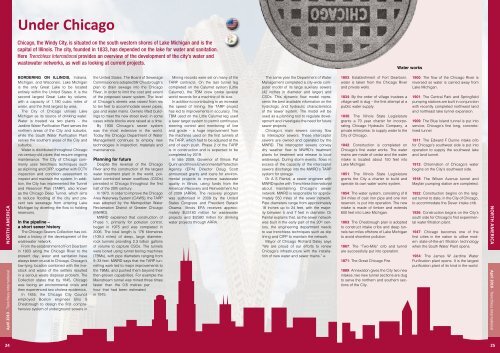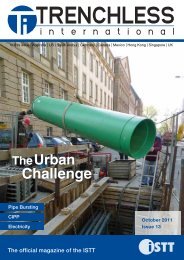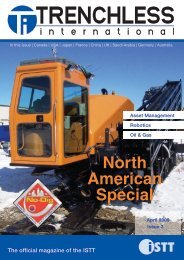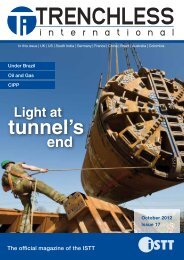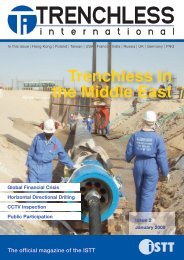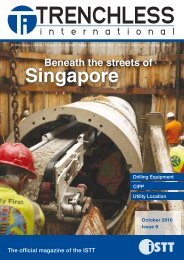Boring - Trenchless International
Boring - Trenchless International
Boring - Trenchless International
You also want an ePaper? Increase the reach of your titles
YUMPU automatically turns print PDFs into web optimized ePapers that Google loves.
Under Chicago<br />
Chicago, the Windy City, is situated on the south western shores of Lake Michigan and is the<br />
capital of Illinois. The city, founded in 1833, has depended on the lake for water and sanitation.<br />
Here <strong>Trenchless</strong> <strong>International</strong> provides an overview of the development of the city’s water and<br />
wastewater networks, as well as looking at current projects.<br />
Water works<br />
North america<br />
April 2010 - <strong>Trenchless</strong> <strong>International</strong><br />
Bordering on Illinois, Indiana,<br />
Michigan, and Wisconsin, Lake Michigan<br />
is the only Great Lake to be located<br />
entirely within the United States. It is the<br />
second largest Great Lake by volume,<br />
with a capacity of 1,180 cubic miles of<br />
water, and the third largest by area.<br />
The City of Chicago utilises Lake<br />
Michigan as its source of drinking water.<br />
Water is treated via two plants – the<br />
Jardine Water Purification Plant serves the<br />
northern areas of the City and suburbs,<br />
while the South Water Purification Plant<br />
serves the southern areas of the City and<br />
suburbs.<br />
Water is distributed throughout Chicago<br />
via century-old pipes that require ongoing<br />
maintenance. The City of Chicago commonly<br />
uses trenchless techniques such<br />
as sliplining and CIPP, together with CCTV<br />
inspection and condition assessment to<br />
inspect and maintain the system. In addition,<br />
the City has implemented the Tunnel<br />
and Reservoir Plan (TARP), also known<br />
as the Chicago Deep Tunnel, which aims<br />
to reduce flooding of the city and prevent<br />
raw sewerage from entering Lake<br />
Michigan by diverting the flow to holding<br />
reservoirs.<br />
In the pipeline –<br />
a short sewer history<br />
The Chicago Sewers Collection has collated<br />
a history of the development of the<br />
wastewater network.<br />
From the establishment of Fort Dearborn<br />
in 1803 along the Chicago River to the<br />
present day, water and sanitation have<br />
always been crucial to Chicago. Chicago’s<br />
low-lying location combined with the livestock<br />
and waste of the settlers resulted<br />
in a serious waste disposal problem. The<br />
Collection states that by 1845, Chicago<br />
was facing an environmental crisis and<br />
then experienced two cholera epidemics.<br />
In 1855, the Chicago City Council<br />
employed Boston engineer Ellis S<br />
Chesbrough to design the first comprehensive<br />
system of underground sewers in<br />
the United States. The Board of Sewerage<br />
Commissioners adopted Mr Chesbrough’s<br />
plan to drain sewage into the Chicago<br />
River, in order to limit the cost and extent<br />
of the proposed sewer system. The level<br />
of Chicago’s streets was raised from six<br />
to ten feet to accommodate sewer pipes,<br />
gas and water mains. Owners lifted buildings<br />
to meet the new street level; in some<br />
cases whole blocks were raised at a time.<br />
By 1930 Chicago’s sewer system<br />
was the most extensive in the world.<br />
Today the Chicago Department of Water<br />
Management continues to employ new<br />
technologies in inspection, materials and<br />
maintenance.<br />
Planning for future<br />
Despite the reversal of the Chicago<br />
River and the construction of the largest<br />
water treatment plant in the world, polluted<br />
combined sewer overflows (CSOs)<br />
persisted in Chicago throughout the first<br />
half of the 20th century.<br />
In 1972, in order to improve the Chicago<br />
Area Waterway System (CAWS), the TARP<br />
was adopted by the Metropolitan Water<br />
Reclamation District of Greater Chicago<br />
(MWRD).<br />
MWRD explained that construction of<br />
Phase 1, primarily for pollution control,<br />
began in 1975 and was completed in<br />
2006. The total length is 176 kilometres<br />
(109.4 miles) of deep, large diameter,<br />
rock tunnels providing 2.3 billion gallons<br />
of volume to capture CSOs. The tunnels<br />
were bored using tunnel boring machines<br />
(TBMs), with pipe diameters ranging from<br />
9–33 feet. MWRD says that the TARP tunnelling<br />
work led to major improvements to<br />
the TBMs, and pushed them beyond their<br />
then-proven capabilities. For example the<br />
Mainstream tunnel was mined three times<br />
faster than the 0.6 metres per<br />
hour that had been estimated<br />
in 1975.<br />
Mining records were set on many of the<br />
TARP contracts. On the last tunnel leg<br />
completed on the Calumet system (Little<br />
Calumet), the TBM crew broke several<br />
world records for a machine of its size.<br />
In addition to contributing to an increase<br />
the speed of mining, the TARP project<br />
has led to improvements in accuracy. The<br />
TBM used on the Little Calumet leg used<br />
a laser target system to permit continuous<br />
steering control and monitoring of line<br />
and grade – a huge improvement from<br />
the machines used on the first tunnels of<br />
the TARP, which had to be adjusted at the<br />
end of each push. Phase 2 of the TARP<br />
is in construction and is expected to be<br />
completed by 2019.<br />
In late 2009, Governor of Illinois Pat<br />
Quinn and Illinois Environmental Protection<br />
Agency (EPA) Director Doug Scott<br />
announced grants and loans for environmental<br />
projects to improve wastewater<br />
quality in Illinois, using funds from the<br />
American Recovery and Reinvestment Act<br />
of 2009 (ARRA). The recovery program<br />
was authorised in 2009 by the United<br />
States Congress and President Barack<br />
Obama. Illinois EPA receives approximately<br />
$US180 million for wastewater<br />
projects and $US80 million for drinking<br />
water projects through ARRA.<br />
The same year the Department of Water<br />
Management completed a city-wide computer<br />
model of its large auxiliary sewers<br />
(42 inches in diameter and larger) and<br />
CSOs. This dynamic flow model represents<br />
the best available information on the<br />
hydrologic and hydraulic characteristics<br />
of the sewer system. The model will be<br />
used as a planning tool to regulate development<br />
and investigate the need for future<br />
sewer projects.<br />
Chicago’s main sewers convey flow<br />
to interceptor sewers. These interceptor<br />
sewers are owned and operated by the<br />
MWRD. The interceptor sewers convey<br />
dry weather flow to MWRD’s treatment<br />
plants for treatment and release to local<br />
waterways. During storm events, flows in<br />
excess of the capacity of the interceptor<br />
sewers discharge into the MWRD’s TARP<br />
system for storage.<br />
Dr A S Paintal, a sewer engineer with<br />
MWRD spoke with <strong>Trenchless</strong> <strong>International</strong><br />
about maintaining Chicago’s sewer<br />
network. MWRD is responsible for approximately<br />
550 miles of the sewer network.<br />
Pipe diameters range from approximately<br />
18 inches up to 24 feet, with the majority<br />
between 5 and 7 feet in diameter. Dr<br />
Paintal explains that, as the sewer network<br />
was built in the early part of the 20 th century,<br />
the engineering department needs<br />
to use trenchless techniques such as slip<br />
lining and CIPP to maintain the network.<br />
Mayor of Chicago Richard Daley says<br />
“We are proud of our efforts to renew<br />
Chicago’s infrastructure with the installation<br />
of new water and sewer mains.”<br />
1803: Establishment of Fort Dearborn,<br />
water is taken from the Chicago River<br />
and private wells.<br />
1834: By the order of village trustees a<br />
village well is dug – the first attempt at a<br />
public water supply.<br />
1836: The Illinois State Legislature<br />
grants a 70 year charter for incorporating<br />
Chicago Hydraulic Company, a<br />
private enterprise, to supply water to the<br />
City of Chicago.<br />
1842: Construction is completed on<br />
Chicago's first water works. The water<br />
mains are made of cedar and the water<br />
intake is located about 150 feet into<br />
Lake Michigan.<br />
1851: The Illinois State Legislature<br />
grants the City a charter to build and<br />
operate its own water works system.<br />
1854: The water system, consisting of 8<br />
3/4 miles of cast iron pipe and one iron<br />
reservoir, is put into operation. The new<br />
intake is made of timber and extends<br />
600 feet into Lake Michigan.<br />
1863: The Chesbrough plan is adopted<br />
to construct intake cribs and deep tunnels<br />
two miles offshore of Lake Michigan<br />
to avoid shoreline pollution.<br />
1867: The “Two-Mile” crib and tunnel<br />
are successfully put into operation.<br />
1871: The Great Chicago Fire.<br />
1889: Annexation gives the City two new<br />
intakes, two new tunnel sections are dug<br />
to serve the northern and southern sections<br />
of the City.<br />
1900: The flow of the Chicago River is<br />
reversed so water is carried away from<br />
Lake Michigan.<br />
1901: The Central Park and Springfield<br />
pumping stations are built in conjunction<br />
with recently completed northwest land<br />
and northeast lake tunnel expansion.<br />
1909: The Blue Island tunnel is put into<br />
service; Chicago’s first long, concretelined<br />
tunnel.<br />
1911: The Edward F Dunne intake crib<br />
for Chicago’s southwest side is put into<br />
operation to supply the southwest lake<br />
and land tunnel.<br />
1912: Chlorination of Chicago’s water<br />
begins on the City’s southwest side.<br />
1918: The Wilson Avenue tunnel and<br />
Mayfair pumping station are completed.<br />
1922: Construction begins on the largest<br />
tunnel to date, in the City of Chicago,<br />
to accommodate the Dever intake crib.<br />
1926: Construction begins on the City’s<br />
south side for Chicago's first experimental<br />
water filtration plant.<br />
1947: Chicago becomes one of the<br />
first cities in the nation to utilise modern<br />
state-of-the-art filtration technology<br />
when the South Water Plant opens.<br />
1964: The James W Jardine Water<br />
Purification plant opens. It is the largest<br />
purification plant of its kind in the world.<br />
North america<br />
April 2010 - <strong>Trenchless</strong> <strong>International</strong><br />
24<br />
25


